Gardens filled with wildflowers are a delightful way to bring a touch of nature’s beauty to your outdoor space. They attract pollinators, add color, and require less maintenance compared to traditional gardens. Plus, planting them supports biodiversity and creates a lively, natural environment where you can unwind and enjoy the simple pleasures of life.
Wildflower Gardens for Wildlife Habitats
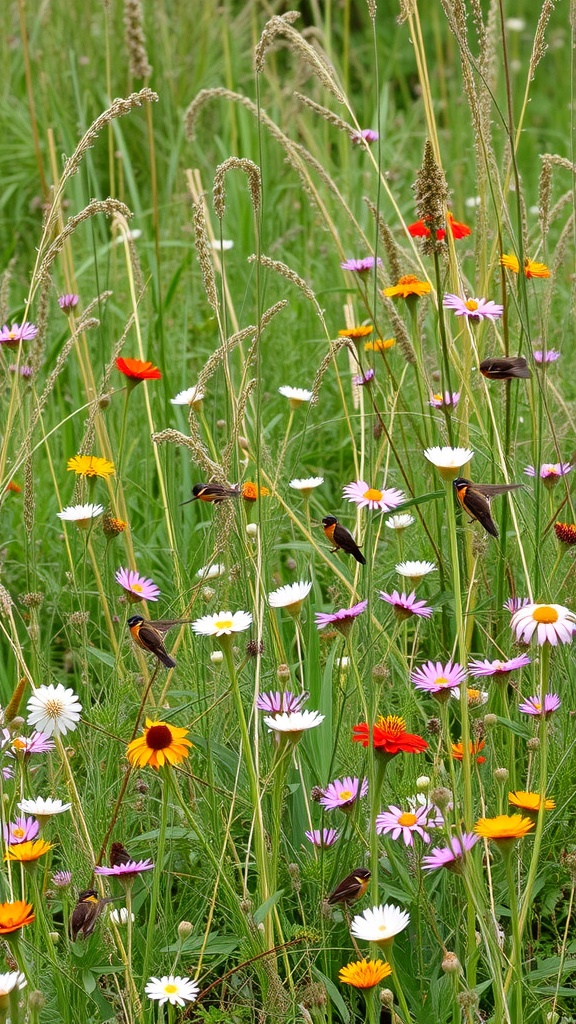
Wildflower gardens are more than just pretty spaces; they serve as vital habitats for various wildlife. The image showcases a vibrant mix of wildflowers, attracting birds and insects alike. These colorful blooms create a lively environment that supports biodiversity.
In this garden, you can spot birds flitting among the flowers, searching for food and shelter. This interaction highlights the importance of planting native species that provide essential resources for local wildlife. By choosing the right plants, you can create a thriving ecosystem right in your backyard.
Wildflower gardens also help pollinators, like bees and butterflies, which are crucial for plant reproduction. The diverse range of flowers ensures that these creatures have access to nectar throughout the growing season. A garden filled with wildflowers not only beautifies your space but also plays a significant role in maintaining ecological balance.
Wildflower Gardens and Soil Health
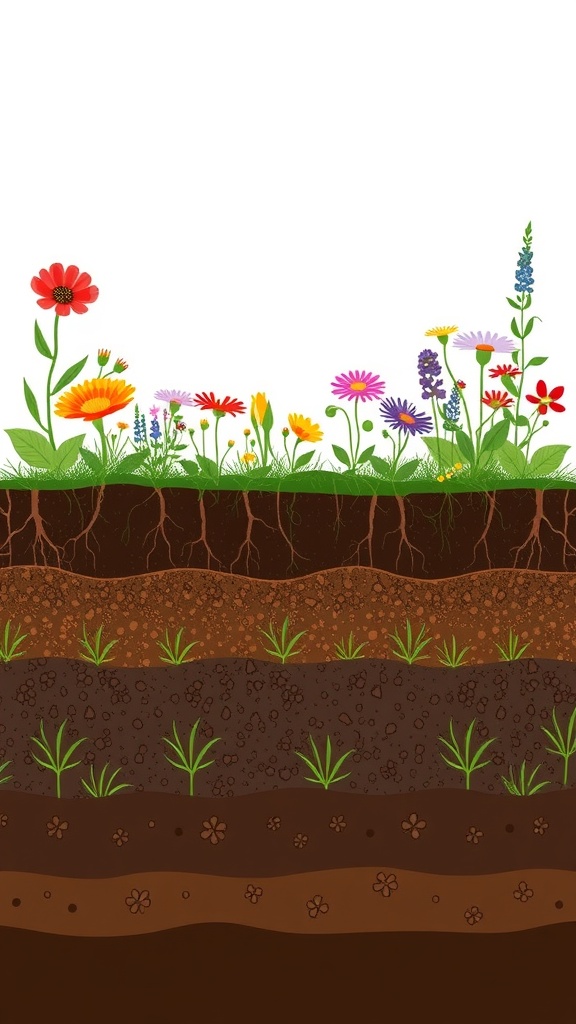
Wildflower gardens are not just a feast for the eyes; they play a big role in maintaining soil health. The vibrant flowers you see above ground are connected to a rich ecosystem below. Healthy soil is crucial for the growth of these wildflowers, and it supports a variety of beneficial organisms.
The image shows a colorful array of wildflowers, with roots extending deep into the soil. This root system helps to aerate the soil, allowing water and nutrients to reach deeper layers. When flowers bloom, they attract pollinators, which are essential for plant reproduction. This interaction boosts biodiversity, making the garden more resilient.
Moreover, wildflowers can improve soil structure. Their roots help to prevent erosion and promote the retention of moisture. This is especially important in areas prone to drought. By planting wildflowers, you’re not just beautifying your space; you’re also contributing to a healthier environment.
Designing with Wildflower Meadows
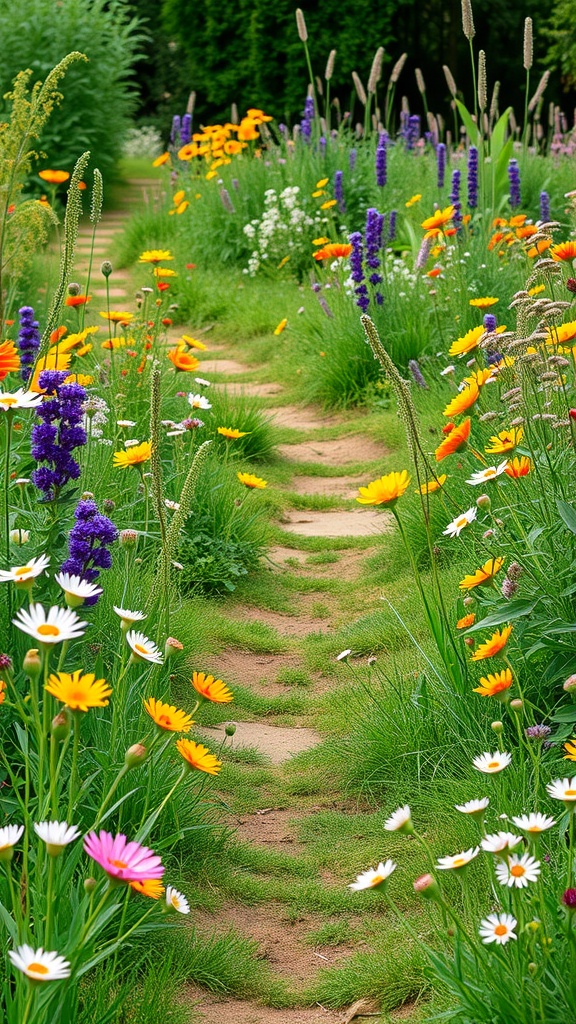
Wildflower meadows bring a burst of color and life to any garden. The image shows a charming path winding through a vibrant display of flowers. Bright yellows, purples, and whites create a lively atmosphere, inviting visitors to stroll and enjoy the beauty.
When designing with wildflowers, think about creating a natural look. Mixing different species can lead to a stunning effect. The flowers not only attract pollinators but also add texture and movement to the landscape. A path like the one in the image can guide visitors through the garden, making it feel welcoming and accessible.
Consider the seasons when selecting flowers. Some bloom in spring, while others shine in summer or fall. This way, your garden stays colorful throughout the year. Maintenance is also simpler with wildflowers, as they often require less water and care than traditional gardens.
Incorporating wildflower meadows into your design can transform your outdoor space into a lively retreat. Whether you have a large yard or a small garden, wildflowers can create a beautiful and inviting environment.
Native Wildflowers for Local Gardens
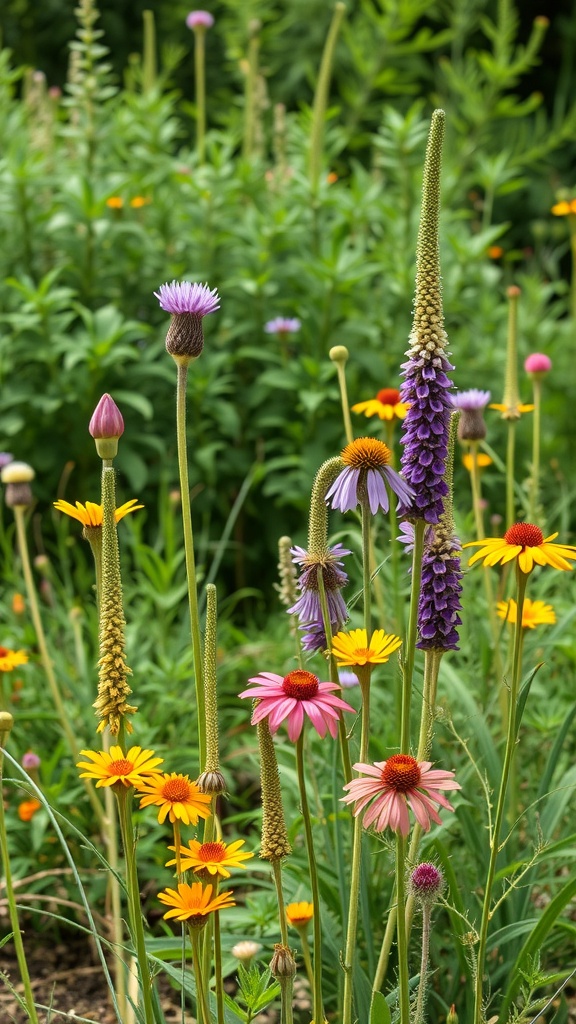
Native wildflowers bring a splash of color and life to any garden. The image shows a vibrant mix of flowers, showcasing their unique shapes and hues. These plants are not just pretty; they play a vital role in supporting local ecosystems.
Choosing native wildflowers for your garden is a great way to attract pollinators like bees and butterflies. The tall purple spikes and cheerful yellow blooms in the image are perfect examples of flowers that thrive in local conditions. They require less maintenance and are well-adapted to the local climate.
Planting a variety of wildflowers can create a beautiful, natural look. The mix of colors and heights adds interest and charm to your garden. Plus, these flowers often bloom at different times, ensuring that your garden looks lively throughout the seasons.
Consider incorporating native species that are known to flourish in your area. This not only enhances your garden’s beauty but also contributes to the health of the local environment. So, grab some seeds and start planting!
Creating a Pollinator Paradise
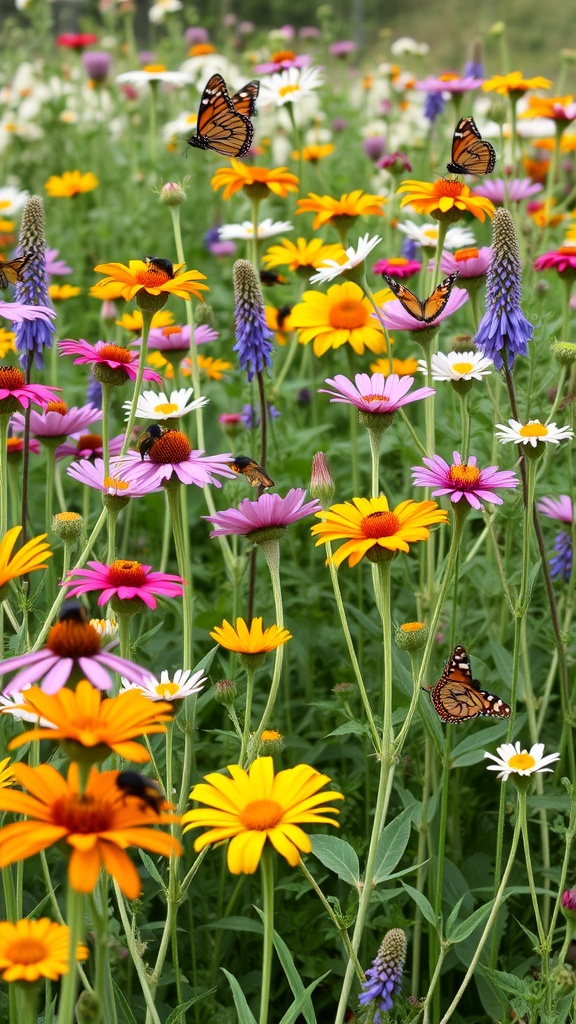
Wildflower gardens are a feast for the eyes and a haven for pollinators. Imagine a vibrant mix of colors, with butterflies fluttering from flower to flower. This scene captures the essence of a pollinator paradise, where bees and butterflies thrive amidst a tapestry of blooms.
In this garden, you’ll see daisies, coneflowers, and vibrant orange blooms, all working together to attract these essential creatures. The variety of shapes and colors not only pleases the eye but also provides different types of nectar and pollen, catering to a range of pollinators.
Creating such a space in your own yard can be simple. Start by choosing native wildflowers that bloom at different times throughout the season. This ensures that there’s always something for pollinators to enjoy. By planting in clusters, you make it easier for them to find food.
Don’t forget to include some taller flowers for butterflies to perch on and some ground cover for bees. A little water source, like a shallow dish with stones, can also help. With a little effort, you can turn your garden into a lively hub for pollinators, supporting their populations while enjoying the beauty they bring.
Wildflower Maintenance Tips
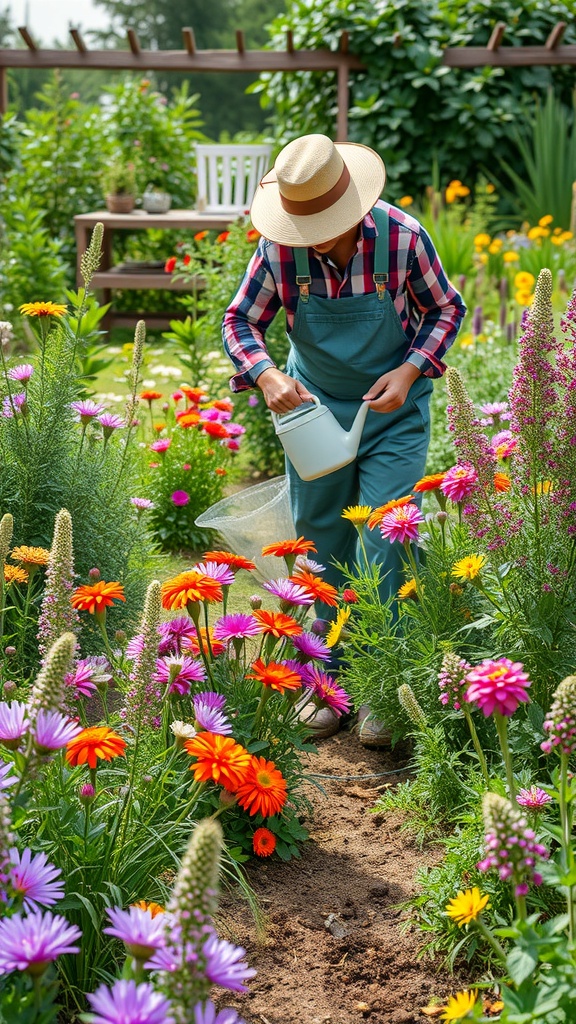
Creating a garden filled with wildflowers is a delightful way to bring nature closer to home. The image shows a person watering vibrant flowers, surrounded by a colorful display of blooms. This scene captures the joy of tending to a wildflower garden, where each flower adds its unique charm.
To keep your wildflower garden thriving, regular watering is key. Make sure to water early in the morning or late in the afternoon to prevent evaporation. It’s best to give your flowers a deep soak rather than light sprinkling. This encourages strong root growth.
Weeding is another important task. Weeds can compete with your wildflowers for nutrients and water. Take some time each week to pull them out. It’s easier to manage when you catch them early!
Mulching can help retain moisture and suppress weeds. A layer of organic mulch around your flowers can do wonders. Plus, it adds a neat look to your garden.
Lastly, don’t forget to enjoy the process! Gardening is not just about the end result; it’s about the moments spent nurturing your plants and watching them grow. A wildflower garden can be a beautiful escape, so take a moment to appreciate your hard work.
Wildflower Color Schemes for Aesthetic Appeal
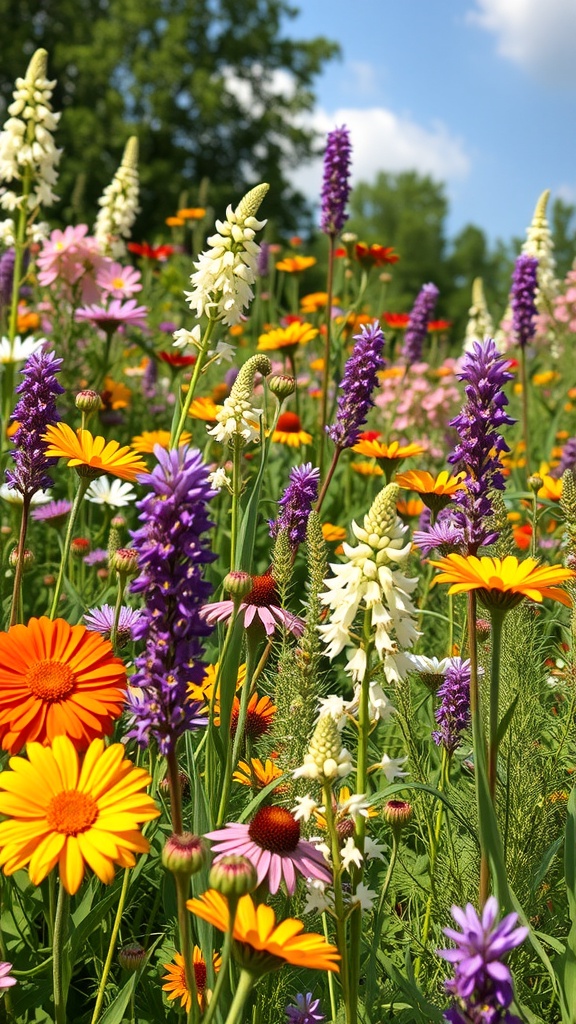
Wildflowers bring a burst of color and life to any garden. The image showcases a vibrant mix of flowers, each contributing to a lively palette. Bright oranges, deep purples, and soft whites create a stunning visual feast.
When planning your wildflower garden, think about how colors work together. Pairing warm tones like yellows and oranges with cooler shades like purples can create a balanced look. This combination not only attracts pollinators but also enhances the overall beauty of your space.
Consider the height and spread of each flower type. Taller flowers can serve as a backdrop, while shorter ones can fill in the foreground. This layering adds depth and interest to your garden. Mixing different shapes and sizes of blooms can also enhance the aesthetic appeal.
Don’t forget about seasonal changes! Some flowers bloom at different times, so planning for a staggered bloom can keep your garden looking fresh throughout the seasons. With a little thought, your wildflower garden can be a colorful retreat all year round.
Seasonal Blooms and Their Benefits
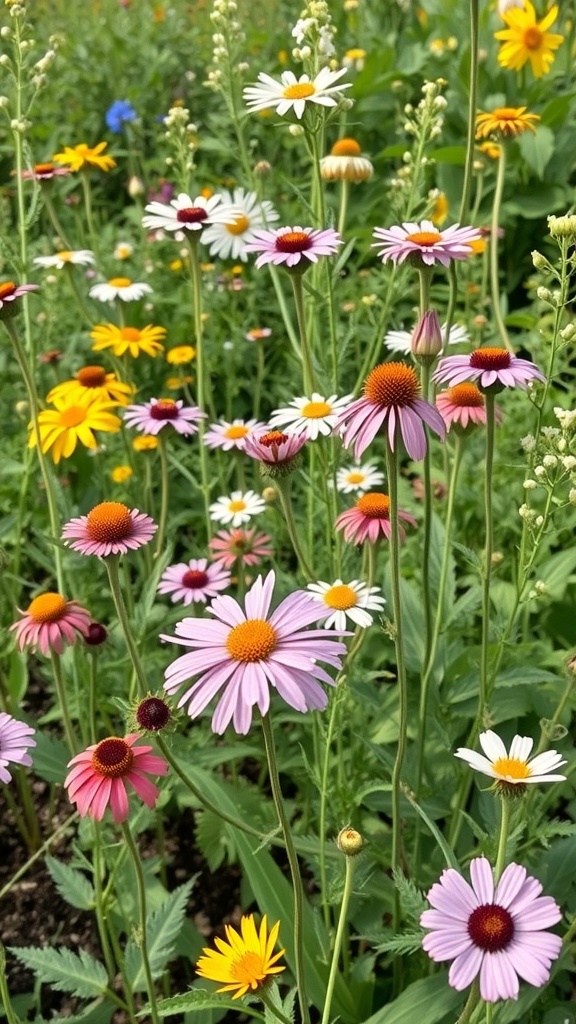
Wildflower gardens are a beautiful sight, especially when they burst into bloom during the warmer months. The image showcases a vibrant mix of flowers, including daisies and colorful coneflowers, each adding its charm to the landscape. These seasonal blooms not only brighten up the garden but also attract various pollinators, creating a lively ecosystem.
Having wildflowers in your garden can bring many benefits. They require less maintenance than traditional gardens, making them perfect for busy lifestyles. Plus, they thrive in various conditions, so you can enjoy their beauty even in less-than-perfect soil.
Wildflowers also play a crucial role in supporting local wildlife. Bees, butterflies, and other pollinators rely on these flowers for food. By planting wildflowers, you contribute to the health of the environment and help sustain these important species.
In addition to their ecological benefits, wildflowers can be a source of joy and relaxation. Spending time in a garden filled with colorful blooms can lift your spirits and provide a calming atmosphere. Whether you’re tending to them or simply enjoying their beauty, wildflowers can enhance your outdoor experience.
Wildflower Gardens in Urban Spaces
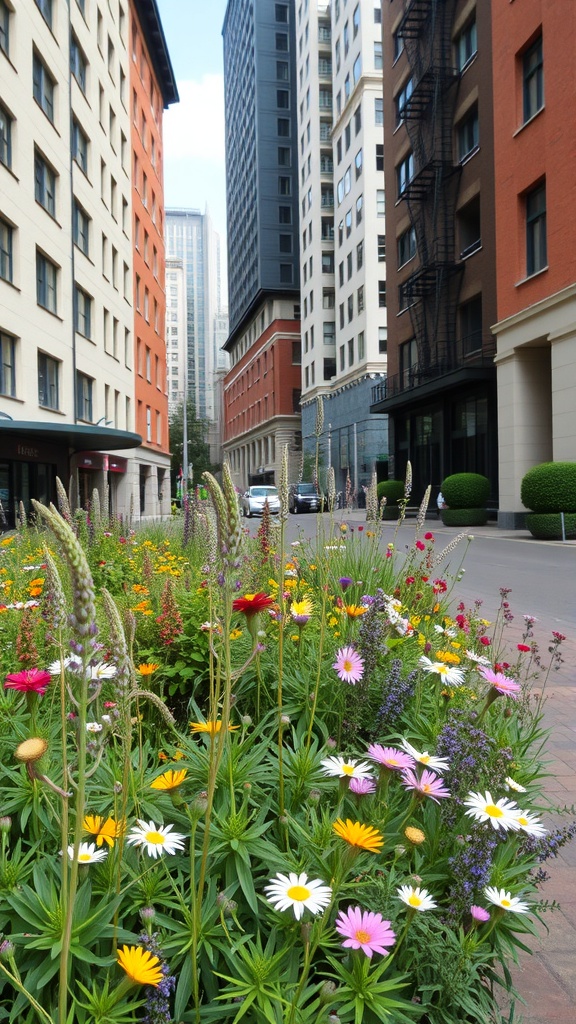
Wildflower gardens bring a splash of color and life to city streets. The image shows a vibrant display of flowers nestled between tall buildings. This mix of nature and urban architecture creates a unique atmosphere.
In cities, wildflower gardens serve as a refreshing escape from concrete and steel. They attract pollinators like bees and butterflies, which are essential for a healthy ecosystem. These gardens can be found in parks, along sidewalks, or even in small patches near buildings.
Planting wildflowers not only beautifies the area but also promotes biodiversity. Residents can enjoy the sight and scent of these flowers while contributing to the environment. It’s a simple way to make urban living a bit greener and more enjoyable.
Wildflowers and Climate Resilience
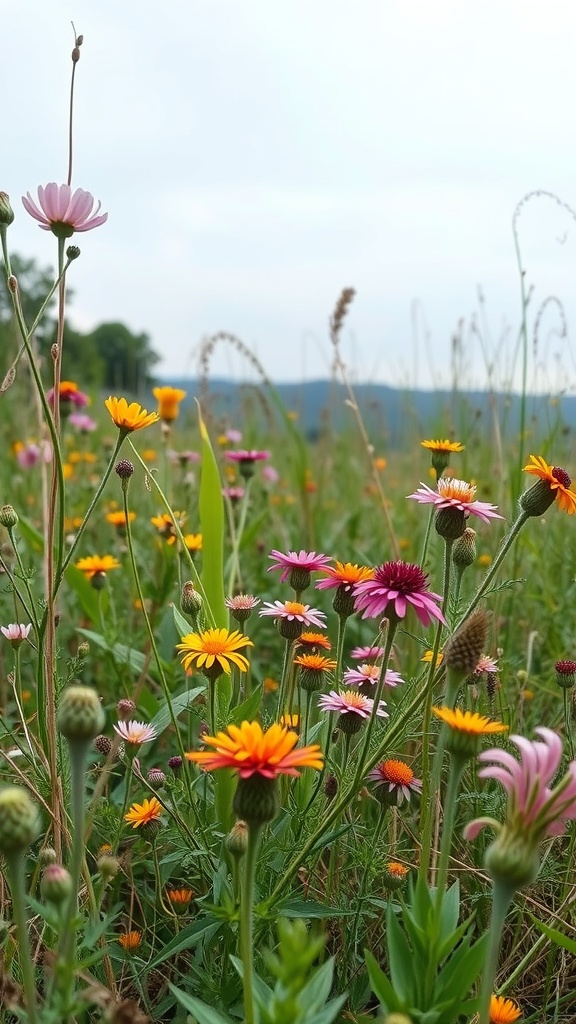
Wildflowers are more than just pretty sights; they play a key role in our ecosystems. The image shows a vibrant mix of wildflowers, each contributing to a healthy environment. These flowers thrive in various conditions, making them resilient to climate changes.
In gardens, wildflowers can adapt to different soil types and moisture levels. This adaptability helps maintain biodiversity, which is crucial for a balanced ecosystem. When planted in gardens, they attract pollinators like bees and butterflies, supporting local wildlife.
Moreover, wildflowers can help prevent soil erosion. Their deep roots hold the soil together, making them excellent for areas prone to runoff. This natural method of soil stabilization is vital, especially in regions facing heavy rains or droughts.
Incorporating wildflowers into your garden not only beautifies the space but also contributes to climate resilience. It’s a simple way to make a positive impact on the environment while enjoying the colorful blooms.
The Role of Wildflowers in Ecosystems
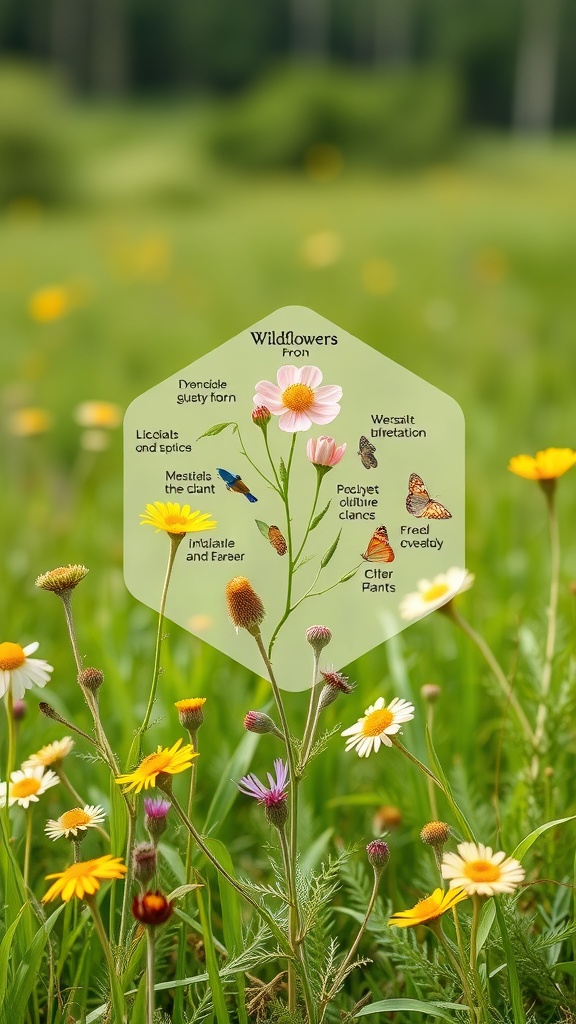
Wildflowers are more than just pretty sights in gardens; they play a key role in local ecosystems. The image shows a variety of wildflowers, each contributing to the environment in unique ways.
These flowers attract pollinators like bees and butterflies, which are essential for plant reproduction. Without them, many plants would struggle to produce seeds. The vibrant colors and diverse shapes of wildflowers make them irresistible to these helpful creatures.
Wildflowers also support other wildlife. Birds and small mammals often rely on them for food and shelter. The presence of these flowers can create a balanced habitat, promoting biodiversity.
Moreover, wildflowers help improve soil health. Their roots can prevent erosion and enhance soil structure, making it easier for other plants to thrive. This interconnectedness shows how wildflowers are vital to maintaining healthy ecosystems.
Incorporating Edible Wildflowers
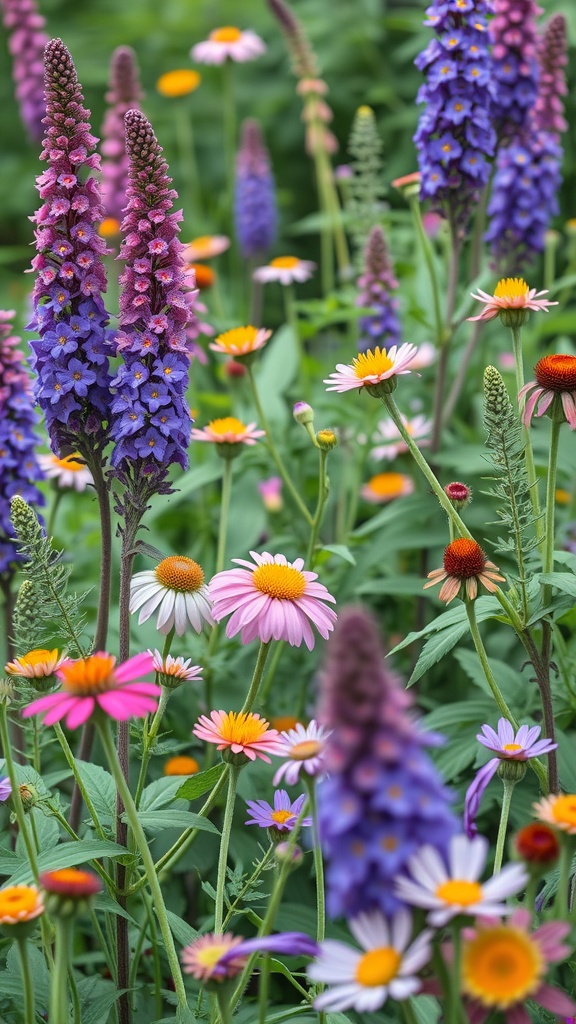
Wildflowers can add a splash of color and flavor to your garden. The image shows a beautiful mix of vibrant flowers, showcasing shades of purple, pink, and orange. These flowers not only look stunning but can also be edible.
Consider adding flowers like nasturtiums, which have a peppery taste, or violets, known for their sweet flavor. Both can enhance salads or be used as garnishes. The daisies in the image can also be edible, offering a mild taste that complements many dishes.
To incorporate these flowers, start by planting them in a sunny spot. Make sure to use organic gardening practices to keep them safe for consumption. Once they bloom, you can harvest the petals for your culinary creations.
Try making a wildflower salad. Gather a mix of edible flowers, greens, and your favorite dressing. The colors and flavors will surely impress your guests!
Wildflower Seed Bombs for Easy Planting
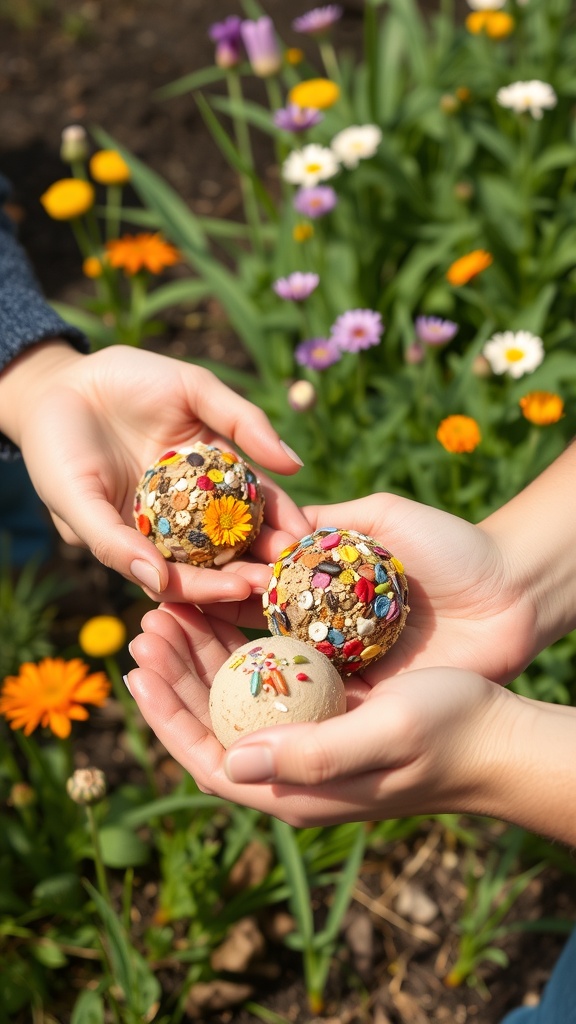
Wildflower seed bombs are a fun and simple way to add beauty to your garden. These little balls, made of seeds, clay, and compost, are perfect for anyone looking to grow wildflowers without much fuss.
In the image, you can see hands holding colorful seed bombs, surrounded by a vibrant mix of blooming flowers. This visual captures the joy of gardening and the creativity involved in making seed bombs. Each bomb is unique, showcasing a variety of seeds that will sprout into a beautiful wildflower garden.
Making your own seed bombs is easy. Just mix wildflower seeds with clay and compost, then roll them into balls. Once they dry, you can toss them in your garden or any bare patch of land. With a little rain and sunshine, you’ll soon see a burst of colors!
These seed bombs not only beautify your space but also support local pollinators. It’s a win-win for nature and your garden!
The Aesthetics of Wildflower Borders
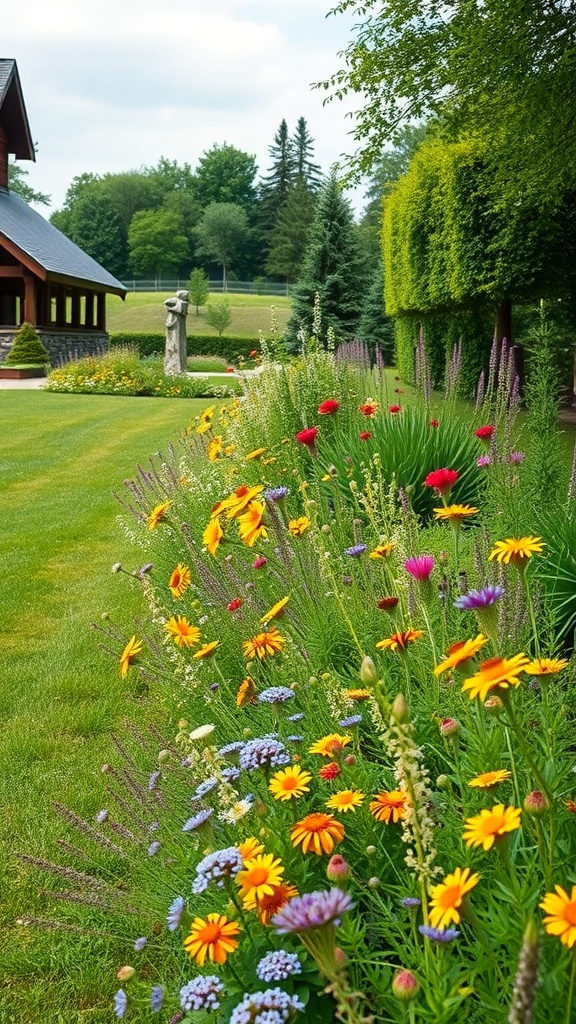
Wildflower borders bring a splash of color and life to any garden. In the image, you can see a vibrant array of flowers lining a neatly manicured lawn. The mix of yellows, reds, and blues creates a cheerful scene that draws the eye and lifts the spirit.
These borders are not just pretty; they also attract pollinators like bees and butterflies. The variety of blooms offers a feast for these important creatures, making your garden a lively hub of activity. The soft sway of the flowers in the breeze adds a gentle movement that enhances the overall charm.
Incorporating wildflowers into your garden design can create a natural look. The flowers seem to dance together, creating a harmonious blend that feels effortless. This approach breaks away from the rigid lines of traditional landscaping, inviting a more relaxed atmosphere.
Whether you have a small patch or a large space, wildflower borders can be tailored to fit. They can frame pathways, highlight features, or simply fill empty spaces with beauty. The key is to choose a mix of flowers that bloom at different times, ensuring your garden stays colorful throughout the seasons.
Sustainable Practices in Wildflower Gardening

Wildflower gardens are a beautiful way to embrace nature while promoting sustainability. The image shows a vibrant mix of wildflowers, showcasing a variety of colors and shapes. This diversity not only pleases the eye but also supports local ecosystems.
One key practice in wildflower gardening is using native plants. These plants are adapted to the local environment and require less water and maintenance. They also attract native pollinators, like bees and butterflies, which are essential for a healthy garden.
Another important aspect is minimizing the use of chemicals. Opting for organic methods helps keep the soil healthy and protects beneficial insects. Simple practices like companion planting can naturally deter pests without harming the ecosystem.
Mulching is another great technique. It helps retain moisture in the soil and reduces the need for frequent watering. Plus, it adds nutrients back into the ground as it breaks down.
Creating a wildflower garden is not just about beauty; it’s about making choices that benefit the environment. By following these sustainable practices, anyone can enjoy a colorful garden while supporting nature.
The Lifecycle of Wildflowers

Wildflowers have a fascinating lifecycle that showcases their resilience and beauty. They start as tiny seeds, often lying dormant in the soil until conditions are just right. When spring arrives, warmth and moisture awaken these seeds, prompting them to sprout.
As they grow, wildflowers reach for the sun, developing stems and leaves. This stage is crucial as they gather energy through photosynthesis. The vibrant colors of their blooms attract pollinators like bees and butterflies, which play a key role in their reproduction.
Once pollinated, wildflowers produce seeds, ensuring the next generation. These seeds can be dispersed by wind, water, or animals, allowing them to spread across various landscapes. Some will find a perfect spot to grow, while others may wait for the right moment.
In gardens filled with wildflowers, you can witness this lifecycle unfold. The mix of colors and shapes creates a lively scene, inviting nature’s helpers and adding charm to any space. Watching wildflowers thrive is a reminder of nature’s cycles and the beauty of growth.
Wildflower Photography Tips
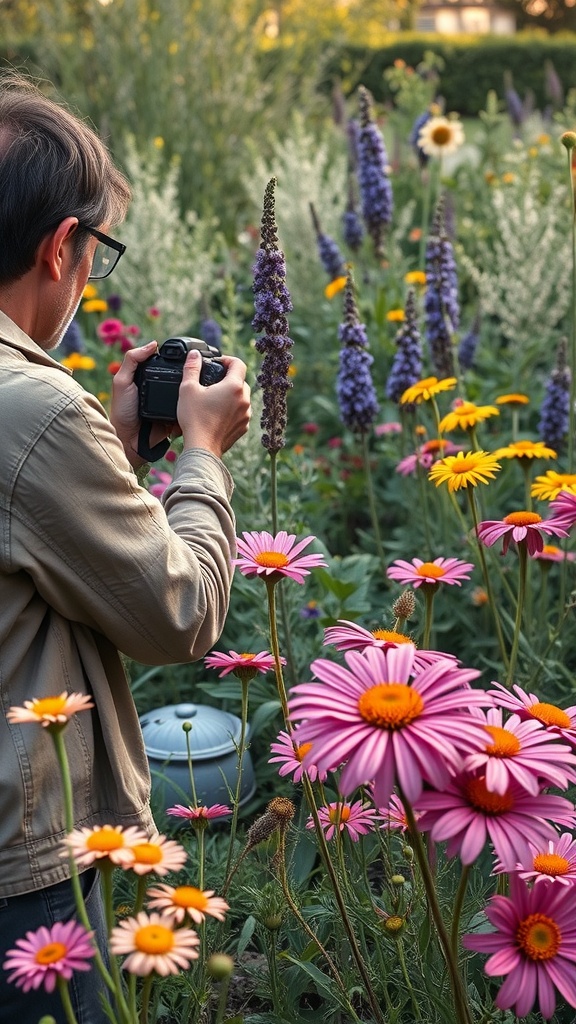
Capturing the beauty of wildflowers can be a rewarding experience. In this vibrant scene, a photographer stands among a colorful array of flowers, camera in hand. The mix of pink daisies, yellow blooms, and tall purple spikes creates a stunning backdrop. This setting is perfect for anyone looking to improve their photography skills.
To get started, consider the time of day. Early morning or late afternoon light can add a warm glow to your images. This soft lighting enhances the colors and details of the flowers. Don’t be afraid to experiment with different angles. Getting low to the ground can provide a unique perspective that showcases the flowers in a fresh way.
Focus on the details. Close-up shots can reveal the intricate textures and patterns of petals. Use a macro lens if you have one, or simply get closer to your subject. Remember to pay attention to your background. A cluttered backdrop can distract from the beauty of the flowers, so look for clean, simple backgrounds that highlight your subject.
Lastly, be patient. Wildlife and changing light conditions can affect your shots. Take your time and enjoy the process. Each click of the shutter is a chance to capture the wild beauty around you.
Wildflower Gardens as Educational Spaces

Wildflower gardens are more than just pretty sights; they serve as fantastic educational spaces. In the image, we see children engaged in learning amidst a vibrant display of wildflowers. This setting is perfect for sparking curiosity and encouraging exploration.
These gardens provide hands-on experiences. Kids can learn about different plant species, their growth cycles, and the importance of biodiversity. The colorful blooms attract various pollinators, offering lessons on ecosystems and the role of insects in our environment.
Outdoor classrooms like this one promote creativity. Children can draw, write, or even plant seeds, making learning interactive and fun. The natural surroundings create a relaxed atmosphere, allowing kids to connect with nature while they learn.
Moreover, wildflower gardens can be used to teach about sustainability. Discussions about native plants and their benefits can inspire future generations to care for the environment. Overall, these gardens are invaluable spaces for education and growth.
